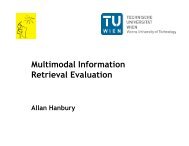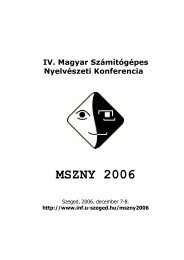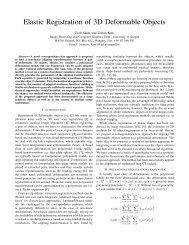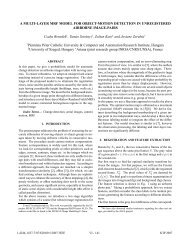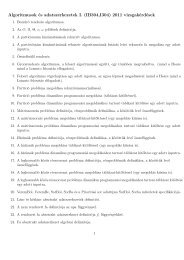- Page 1 and 2: A. Tanács, D. Csendes, V. Vincze,
- Page 3 and 4: Preface We are very pleased to hold
- Page 5 and 6: Table of Contents Papers Consistent
- Page 7 and 8: vii Methods and Results of the Hung
- Page 9: Papers
- Page 12 and 13: 4 Javier Álvez et al. the KNOW Pro
- Page 14 and 15: 6 Javier Álvez et al. 1stOrderEnti
- Page 16 and 17: 8 Javier Álvez et al. that WordNet
- Page 18 and 19: 10 Javier Álvez et al. - 214 featu
- Page 20 and 21: 12 Javier Álvez et al. {Bandung_1
- Page 22 and 23: 14 Javier Álvez et al. Fig. 2. The
- Page 24 and 25: 16 Javier Álvez et al. (3) Althoug
- Page 26 and 27: 18 Javier Álvez et al. 5 Quantitat
- Page 28 and 29: 20 Javier Álvez et al. 29. Schulz,
- Page 30 and 31: 22 Manuela Angioni, Roberto Demonti
- Page 32 and 33: 24 Manuela Angioni, Roberto Demonti
- Page 34 and 35: 26 Manuela Angioni, Roberto Demonti
- Page 36 and 37: 28 Manuela Angioni, Roberto Demonti
- Page 38 and 39: 30 Manuela Angioni, Roberto Demonti
- Page 40 and 41: 32 Manuela Angioni, Roberto Demonti
- Page 42 and 43: 34 Manuela Angioni, Roberto Demonti
- Page 44 and 45: 36 Irina V.Azarova, Anna S. Marina,
- Page 48 and 49: 40 Irina V.Azarova, Anna S. Marina,
- Page 50 and 51: 42 Irina V.Azarova, Anna S. Marina,
- Page 52 and 53: Some Issues in the Construction of
- Page 54 and 55: 46 Valentina Balkova, Andrey Sukhon
- Page 56 and 57: 48 Valentina Balkova, Andrey Sukhon
- Page 58 and 59: 50 Valentina Balkova, Andrey Sukhon
- Page 60 and 61: 52 Valentina Balkova, Andrey Sukhon
- Page 62 and 63: 54 Valentina Balkova, Andrey Sukhon
- Page 64 and 65: A Comparison of Feature Norms and W
- Page 66 and 67: 58 Eduard Barbu and Massimo Poesio
- Page 68 and 69: 60 Eduard Barbu and Massimo Poesio
- Page 70 and 71: 62 Eduard Barbu and Massimo Poesio
- Page 72 and 73: 64 Eduard Barbu and Massimo Poesio
- Page 74 and 75: 66 Eduard Barbu and Massimo Poesio
- Page 76 and 77: 68 Eduard Barbu and Massimo Poesio
- Page 78 and 79: 70 Eduard Barbu and Massimo Poesio
- Page 80 and 81: 72 Eduard Barbu and Massimo Poesio
- Page 82 and 83: Enhancing WordNets with Morphologic
- Page 84 and 85: 76 Sonja Bosch, Christiane Fellbaum
- Page 86 and 87: 78 Sonja Bosch, Christiane Fellbaum
- Page 88 and 89: 80 Sonja Bosch, Christiane Fellbaum
- Page 90 and 91: 82 Sonja Bosch, Christiane Fellbaum
- Page 92 and 93: 84 Sonja Bosch, Christiane Fellbaum
- Page 94 and 95: 86 Sonja Bosch, Christiane Fellbaum
- Page 96 and 97:
88 Sonja Bosch, Christiane Fellbaum
- Page 98 and 99:
90 Sonja Bosch, Christiane Fellbaum
- Page 100 and 101:
92 Cristina Butnariu and Tony Veale
- Page 102 and 103:
94 Cristina Butnariu and Tony Veale
- Page 104 and 105:
96 Cristina Butnariu and Tony Veale
- Page 106 and 107:
98 Cristina Butnariu and Tony Veale
- Page 108 and 109:
100 Cristina Butnariu and Tony Veal
- Page 110 and 111:
102 Thatsanee Charoenporn et al. la
- Page 112 and 113:
104 Thatsanee Charoenporn et al. Fi
- Page 114 and 115:
106 Thatsanee Charoenporn et al. L:
- Page 116 and 117:
108 Thatsanee Charoenporn et al. Ta
- Page 118 and 119:
110 Thatsanee Charoenporn et al. 6.
- Page 120 and 121:
112 Peter Clark, Christiane Fellbau
- Page 122 and 123:
114 Peter Clark, Christiane Fellbau
- Page 124 and 125:
116 Peter Clark, Christiane Fellbau
- Page 126 and 127:
118 Peter Clark, Christiane Fellbau
- Page 128 and 129:
An Evaluation Procedure for Word Ne
- Page 130 and 131:
122 Irene Cramer and Marc Finthamme
- Page 132 and 133:
124 Irene Cramer and Marc Finthamme
- Page 134 and 135:
126 Irene Cramer and Marc Finthamme
- Page 136 and 137:
128 Irene Cramer and Marc Finthamme
- Page 138 and 139:
130 Irene Cramer and Marc Finthamme
- Page 140 and 141:
132 Irene Cramer and Marc Finthamme
- Page 142 and 143:
134 Irene Cramer and Marc Finthamme
- Page 144 and 145:
136 Irene Cramer and Marc Finthamme
- Page 146 and 147:
138 Irene Cramer and Marc Finthamme
- Page 148 and 149:
140 Irene Cramer and Marc Finthamme
- Page 150 and 151:
142 Irene Cramer and Marc Finthamme
- Page 152 and 153:
144 Irene Cramer and Marc Finthamme
- Page 154 and 155:
146 Irene Cramer and Marc Finthamme
- Page 156 and 157:
148 Gerard de Melo and Gerhard Weik
- Page 158 and 159:
150 Gerard de Melo and Gerhard Weik
- Page 160 and 161:
152 Gerard de Melo and Gerhard Weik
- Page 162 and 163:
154 Gerard de Melo and Gerhard Weik
- Page 164 and 165:
156 Gerard de Melo and Gerhard Weik
- Page 166 and 167:
158 Gerard de Melo and Gerhard Weik
- Page 168 and 169:
160 Gerard de Melo and Gerhard Weik
- Page 170 and 171:
Words, Concepts and Relations in th
- Page 172 and 173:
164 Magdalena Derwojedowa et al. Wo
- Page 174 and 175:
166 Magdalena Derwojedowa et al. ku
- Page 176 and 177:
168 Magdalena Derwojedowa et al. ev
- Page 178 and 179:
170 Magdalena Derwojedowa et al. Fi
- Page 180 and 181:
172 Magdalena Derwojedowa et al. 3.
- Page 182 and 183:
174 Magdalena Derwojedowa et al. of
- Page 184 and 185:
176 Magdalena Derwojedowa et al. Re
- Page 186 and 187:
Exploring and Navigating: Tools for
- Page 188 and 189:
180 Marc Finthammer and Irene Crame
- Page 190 and 191:
182 Marc Finthammer and Irene Crame
- Page 192 and 193:
184 Marc Finthammer and Irene Crame
- Page 194 and 195:
186 Darja Fišer 2 Methodology 2.1
- Page 196 and 197:
188 Darja Fišer (1) a Det-Noun phr
- Page 198 and 199:
190 Darja Fišer 4 Evaluation 4.1 S
- Page 200 and 201:
192 Darja Fišer Acknowledgements I
- Page 202 and 203:
The Global WordNet Grid Software De
- Page 204 and 205:
196 Aleš Horák, Karel Pala, and A
- Page 206 and 207:
198 Aleš Horák, Karel Pala, and A
- Page 208 and 209:
The Development of a Complex-Struct
- Page 210 and 211:
202 Aleš Horák, Piek Vossen, and
- Page 212 and 213:
204 Aleš Horák, Piek Vossen, and
- Page 214 and 215:
206 Aleš Horák, Piek Vossen, and
- Page 216 and 217:
208 Aleš Horák, Piek Vossen, and
- Page 218 and 219:
210 Chu-Ren Huang, Chiyo Hotani, Tz
- Page 220 and 221:
212 Chu-Ren Huang, Chiyo Hotani, Tz
- Page 222 and 223:
214 Chu-Ren Huang, Chiyo Hotani, Tz
- Page 224 and 225:
216 Chu-Ren Huang, Chiyo Hotani, Tz
- Page 226 and 227:
218 Chu-Ren Huang, Chiyo Hotani, Tz
- Page 228 and 229:
Paranymy: Enriching Ontological Kno
- Page 230 and 231:
222 Chu-Ren Huang, Pei-Yi Hsiao, I-
- Page 232 and 233:
224 Chu-Ren Huang, Pei-Yi Hsiao, I-
- Page 234 and 235:
226 Chu-Ren Huang, Pei-Yi Hsiao, I-
- Page 236 and 237:
228 Chu-Ren Huang, Pei-Yi Hsiao, I-
- Page 238 and 239:
230 Kadri Kerner The modal verbs ar
- Page 240 and 241:
232 Kadri Kerner Sometimes the near
- Page 242 and 243:
234 Kadri Kerner Some researchers [
- Page 244 and 245:
236 Kadri Kerner Ettevõtmine Toime
- Page 246 and 247:
238 Kadri Kerner Conference on Lang
- Page 248 and 249:
240 Svetla Koeva, Cvetana Krstev, a
- Page 250 and 251:
242 Svetla Koeva, Cvetana Krstev, a
- Page 252 and 253:
244 Svetla Koeva, Cvetana Krstev, a
- Page 254 and 255:
246 Svetla Koeva, Cvetana Krstev, a
- Page 256 and 257:
248 Svetla Koeva, Cvetana Krstev, a
- Page 258 and 259:
250 Svetla Koeva, Cvetana Krstev, a
- Page 260 and 261:
252 Svetla Koeva, Cvetana Krstev, a
- Page 262 and 263:
Language Independent and Language D
- Page 264 and 265:
256 Judit Kuti, Károly Varasdi, Á
- Page 266 and 267:
258 Judit Kuti, Károly Varasdi, Á
- Page 268 and 269:
260 Judit Kuti, Károly Varasdi, Á
- Page 270 and 271:
262 Judit Kuti, Károly Varasdi, Á
- Page 272 and 273:
264 Judit Kuti, Károly Varasdi, Á
- Page 274 and 275:
266 Judit Kuti, Károly Varasdi, Á
- Page 276 and 277:
268 Judit Kuti, Károly Varasdi, Á
- Page 278 and 279:
270 Jurie le Roux, Koliswa Moropa,
- Page 280 and 281:
272 Jurie le Roux, Koliswa Moropa,
- Page 282 and 283:
274 Jurie le Roux, Koliswa Moropa,
- Page 284 and 285:
276 Jurie le Roux, Koliswa Moropa,
- Page 286 and 287:
278 Jurie le Roux, Koliswa Moropa,
- Page 288 and 289:
280 Jurie le Roux, Koliswa Moropa,
- Page 290 and 291:
282 Harald Lüngen, Claudia Kunze,
- Page 292 and 293:
284 Harald Lüngen, Claudia Kunze,
- Page 294 and 295:
286 Harald Lüngen, Claudia Kunze,
- Page 296 and 297:
288 Harald Lüngen, Claudia Kunze,
- Page 298 and 299:
290 Harald Lüngen, Claudia Kunze,
- Page 300 and 301:
292 Harald Lüngen, Claudia Kunze,
- Page 302 and 303:
294 Harald Lüngen, Claudia Kunze,
- Page 304 and 305:
296 Harald Lüngen, Claudia Kunze,
- Page 306 and 307:
298 Niloofar Mansoory and Mahmood B
- Page 308 and 309:
300 Niloofar Mansoory and Mahmood B
- Page 310 and 311:
302 Niloofar Mansoory and Mahmood B
- Page 312 and 313:
Towards a Morphodynamic WordNet of
- Page 314 and 315:
306 Nazaire Mbame 3.1 The semantic
- Page 316 and 317:
308 Nazaire Mbame from the proto mi
- Page 318 and 319:
310 Nazaire Mbame 4 Conclusion As s
- Page 320 and 321:
312 Márton Miháltz et al. word se
- Page 322 and 323:
314 Márton Miháltz et al. to the
- Page 324 and 325:
316 Márton Miháltz et al. 2.3 Adv
- Page 326 and 327:
318 Márton Miháltz et al. 3.2 Eva
- Page 328 and 329:
320 Márton Miháltz et al. and sem
- Page 330 and 331:
322 Rajat Kumar Mohanty et al. 1 In
- Page 332 and 333:
324 Rajat Kumar Mohanty et al. Tabl
- Page 334 and 335:
326 Rajat Kumar Mohanty et al. Mara
- Page 336 and 337:
328 Rajat Kumar Mohanty et al. Tabl
- Page 338 and 339:
330 Rajat Kumar Mohanty et al. Fig.
- Page 340 and 341:
332 Rajat Kumar Mohanty et al. Once
- Page 342 and 343:
Estonian WordNet: Nowadays Heili Or
- Page 344 and 345:
336 Heili Orav, Kadri Vider, Neeme
- Page 346 and 347:
338 Heili Orav, Kadri Vider, Neeme
- Page 348 and 349:
340 Bolette Sandford Pedersen and S
- Page 350 and 351:
342 Bolette Sandford Pedersen and S
- Page 352 and 353:
344 Bolette Sandford Pedersen and S
- Page 354 and 355:
346 Bolette Sandford Pedersen and S
- Page 356 and 357:
348 Bolette Sandford Pedersen and S
- Page 358 and 359:
350 Ida Raffaelli, Marko Tadić, Bo
- Page 360 and 361:
352 Ida Raffaelli, Marko Tadić, Bo
- Page 362 and 363:
354 Ida Raffaelli, Marko Tadić, Bo
- Page 364 and 365:
356 Ida Raffaelli, Marko Tadić, Bo
- Page 366 and 367:
358 Ida Raffaelli, Marko Tadić, Bo
- Page 368 and 369:
Towards Automatic Evaluation of Wor
- Page 370 and 371:
362 J. Ramanand and Pushpak Bhattac
- Page 372 and 373:
364 J. Ramanand and Pushpak Bhattac
- Page 374 and 375:
366 J. Ramanand and Pushpak Bhattac
- Page 376 and 377:
368 J. Ramanand and Pushpak Bhattac
- Page 378 and 379:
370 J. Ramanand and Pushpak Bhattac
- Page 380 and 381:
372 J. Ramanand and Pushpak Bhattac
- Page 382 and 383:
374 J. Ramanand and Pushpak Bhattac
- Page 384 and 385:
376 Nils Reiter and Paul Buitelaar
- Page 386 and 387:
378 Nils Reiter and Paul Buitelaar
- Page 388 and 389:
380 Nils Reiter and Paul Buitelaar
- Page 390 and 391:
382 Nils Reiter and Paul Buitelaar
- Page 392 and 393:
384 Nils Reiter and Paul Buitelaar
- Page 394 and 395:
386 Nils Reiter and Paul Buitelaar
- Page 396 and 397:
388 Horacio Rodríguez et al. synse
- Page 398 and 399:
390 Horacio Rodríguez et al. Since
- Page 400 and 401:
392 Horacio Rodríguez et al. they
- Page 402 and 403:
394 Horacio Rodríguez et al. 3.2.2
- Page 404 and 405:
396 Horacio Rodríguez et al. Table
- Page 406 and 407:
398 Horacio Rodríguez et al. A bas
- Page 408 and 409:
400 Horacio Rodríguez et al. :
- Page 410 and 411:
402 Horacio Rodríguez et al. Table
- Page 412 and 413:
404 Horacio Rodríguez et al. Ackno
- Page 414 and 415:
Building a WordNet for Persian Verb
- Page 416 and 417:
408 Masoud Rouhizadeh, Mehrnoush Sh
- Page 418 and 419:
410 Masoud Rouhizadeh, Mehrnoush Sh
- Page 420 and 421:
412 Masoud Rouhizadeh, Mehrnoush Sh
- Page 422 and 423:
414 Mehrnoush Shamsfard semantic re
- Page 424 and 425:
416 Mehrnoush Shamsfard 1- Providin
- Page 426 and 427:
418 Mehrnoush Shamsfard FarsNet for
- Page 428 and 429:
420 Virach Sornlertlamvanich et al.
- Page 430 and 431:
422 Virach Sornlertlamvanich et al.
- Page 432 and 433:
424 Virach Sornlertlamvanich et al.
- Page 434 and 435:
426 Virach Sornlertlamvanich et al.
- Page 436 and 437:
Extraction of Selectional Preferenc
- Page 438 and 439:
430 Dennis Spohr defined as follows
- Page 440 and 441:
432 Dennis Spohr the most recent ma
- Page 442 and 443:
434 Dennis Spohr ... 00058624-n 00
- Page 444 and 445:
436 Dennis Spohr hierarchy (cf. Sec
- Page 446 and 447:
438 Dennis Spohr 5.2 Evaluation of
- Page 448 and 449:
440 Dennis Spohr ington, DC (1997)
- Page 450 and 451:
442 Dan Tufiş, Radu Ion, Luigi Boz
- Page 452 and 453:
444 Dan Tufiş, Radu Ion, Luigi Boz
- Page 454 and 455:
446 Dan Tufiş, Radu Ion, Luigi Boz
- Page 456 and 457:
448 Dan Tufiş, Radu Ion, Luigi Boz
- Page 458 and 459:
450 Dan Tufiş, Radu Ion, Luigi Boz
- Page 460 and 461:
452 Dan Tufiş, Radu Ion, Luigi Boz
- Page 462 and 463:
454 Tony Veale and Yanfen Hao this
- Page 464 and 465:
456 Tony Veale and Yanfen Hao 3 Est
- Page 466 and 467:
458 Tony Veale and Yanfen Hao peaco
- Page 468 and 469:
460 Tony Veale and Yanfen Hao While
- Page 470 and 471:
Comparing WordNet Relations to Lexi
- Page 472 and 473:
464 Veronika Vincze, Attila Almási
- Page 474 and 475:
466 Veronika Vincze, Attila Almási
- Page 476 and 477:
468 Veronika Vincze, Attila Almási
- Page 478 and 479:
470 Veronika Vincze, Attila Almási
- Page 480 and 481:
472 Veronika Vincze, Attila Almási
- Page 482 and 483:
KYOTO: A System for Mining, Structu
- Page 484 and 485:
476 Piek Vossen et al. KYOTO's prin
- Page 486 and 487:
478 Piek Vossen et al. [13, 14, 15,
- Page 488 and 489:
480 Piek Vossen et al. 7 Sharing Kn
- Page 490 and 491:
482 Piek Vossen et al. discuss the
- Page 492 and 493:
484 Piek Vossen et al. COLING/ACL 2
- Page 494 and 495:
486 Piek Vossen et al. structures w
- Page 496 and 497:
488 Piek Vossen et al. original ide
- Page 498 and 499:
490 Piek Vossen et al. 3 Aligning a
- Page 500 and 501:
492 Piek Vossen et al. 4 Aligning M
- Page 502 and 503:
494 Piek Vossen et al. 4.2 Nouns an
- Page 504 and 505:
496 Piek Vossen et al. 4.3 Adjectiv
- Page 506 and 507:
498 Piek Vossen et al. 4.4 Multiwor
- Page 508 and 509:
500 Piek Vossen et al. Interchange
- Page 510 and 511:
502 Piek Vossen et al. There exists
- Page 512 and 513:
504 Piek Vossen et al. does not dow
- Page 514 and 515:
CWN-Viz : Semantic Relation Visuali
- Page 516 and 517:
508 Ming-Wei Xu, Jia-Fei Hong, Shu-
- Page 518 and 519:
510 Ming-Wei Xu, Jia-Fei Hong, Shu-
- Page 520 and 521:
512 Ming-Wei Xu, Jia-Fei Hong, Shu-
- Page 522 and 523:
514 Ming-Wei Xu, Jia-Fei Hong, Shu-
- Page 524 and 525:
516 Ming-Wei Xu, Jia-Fei Hong, Shu-
- Page 526 and 527:
518 Ming-Wei Xu, Jia-Fei Hong, Shu-
- Page 528 and 529:
Using WordNet in Extracting the Fin
- Page 530 and 531:
522 Mahsa A. Yarmohammadi et al. an
- Page 532 and 533:
524 Mahsa A. Yarmohammadi et al. 3.
- Page 534 and 535:
526 Mahsa A. Yarmohammadi et al. A
- Page 536 and 537:
528 Mahsa A. Yarmohammadi et al. -V
- Page 538 and 539:
530 Mahsa A. Yarmohammadi et al. sa
- Page 540 and 541:
532 Hamza Zidoum conceptual identif
- Page 542 and 543:
534 Hamza Zidoum 2.2 Semantic Relat
- Page 544 and 545:
536 Hamza Zidoum WordNet, since it
- Page 546 and 547:
538 Hamza Zidoum The lexicographer
- Page 548 and 549:
540 Hamza Zidoum Table 3. Test Case
- Page 550 and 551:
542 Hamza Zidoum 5.3 Future Work Ou
- Page 552 and 553:
544 Hamza Zidoum 26. Modern Standar
- Page 554:
546 Moropa, K. 269 Neri, F. 474 Nim







